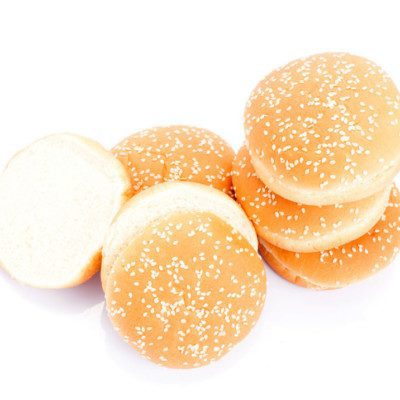In 1916, the first hamburger bun as it is exists today was made by Walter Anderson. This short and squat bun is what is now the standard for hamburger buns. Now, a number of variations can include kaiser rolls, pretzel rolls, or onion rolls, which can be made with dried or crispy onions.
How are hamburger buns made?
The following ingredients can be found in hamburger buns:1
- Wheat flour
- Water
- Yeast
- Salt
- Fat: Shortening, vegetable oil, butter, ghee or lard
- Milk: Nonfat dried milk, buttermilk or whey
- Egg
- Sugar
- Enzymes
- Non-wheat flours, non-wheat meals, non-wheat grits, wheat and non-wheat starches
- Dough conditioners like potassium bromate, calcium bromate, potassium iodate, calcium iodate, calcium peroxide, azodicarbonamide
- Colors and spices, spice oils, and spice extracts
Hamburger bun formula using a straight dough method
| Ingredient | Baker’s % |
| Flour | 100 |
| Water | 65 |
| Ice | 2 |
| Sugar | 13 |
| Dry Yeast | 4 |
| Soy Oil | 3 |
| Salt | 2 |
| Dough Conditioner | 0.25-0.5 |
Process for making hamburger buns
- Dispense all dry ingredients into a horizontal mixer.
- Add in the water, brew and/or ice.
- Mix on low until dough has cleaned up (no visible flour on the surface).
- Mix on high until the dough is fully developed.
- A delayed salt addition can be performed at 75% of the full mixing time.
- Turn dough out into the dough trough and measure its temperature. Target a temperature of 27oC (80oF).
- Transfer dough.
- Process dough through the dough divider and intermediate proofer.
- Sheet it out onto hamburger bun pans and proof until it doubles in size. If the buns require imprints, this should be done before the proofer.
- Apply a water score or toppings after dough exits the proofer, and just before it enters the oven.
- Bake it in a multizone oven in a range of 199–218oC (390–425oF) for about 10–12 minutes. Dough density and steam will affect these ranges.
- Cool the buns to an internal temperature of 35–40ºC (95–104ºF).
- Slice, then bag the buns.
Techniques
Water brews and flour brews are commonly used as prior fermentation before dough-making. In water brews, 3% yeast (based on flour weight), 3.5–4.5% sugar (based on flour weight), and salt, are mixed and fermented with a brew buffer for 60–90 min.2 In flour brews, a proportion of the flour (40-50% of the total), yeast, salt and water are mixed and fermented.2 Total titratable acidity or pH is used to evaluate the brew development. Hamburger buns made with prior fermentation have softer loaf, cleaner cut, better keeping quality, improved flavor and aroma, a more resilient crumb and an improved sheen.
Refrigerated liquid flour brew can be added to the high-speed mixer to control dough temperatures. For example, half the weight of each mix can be refrigerated flour brew when a 40% flour brew is used.2
The production of hamburger buns requires a strong flour to obtain dough with good viscoelastic characteristics, gas retention and a final product with a good volume and a uniform crumb.3 A strong dough is also required to carry the high levels of fat and sugar.
Bread flour (hard wheat) is usually used for hamburger bun production. This could come from a mixture of 50% winter wheat and 50% spring wheat. Better-quality buns come from a higher concentration of spring wheat, targeting a protein content of 12%.
Sucrose and fat substitutes can be used to produce a reduced-calorie hamburger bun. Attributes like firmness, cohesiveness, springiness and chewiness are not drastically affected by these substitutes.4
If buns are not used within three days of production, calcium propionate or natural mold inhibitors can be used. In addition, shelf-life extension can be achieved through enzymes.
FDA regulations
The FDA indicates the requirements for hamburger buns in article 21CFR136.110 of the Code of Federal Regulations:1
- Dairy ingredients in hamburger buns may be used in a quantity not to exceed 0.8% by weight.
- Total quantity of non-wheat flours and wheat starches may not be more than 3% by weight of flour used.
- The quantity of ground dehulled soybeans may not be more than 0.5% by weight of flour used.
- Calcium propionate may be used as a preservative without limitation. The quantity of monocalcium phosphate may not be more than 0.75% of flour weight. The total quantity of other calcium salts and yeast nutrients may not exceed 0.25% of flour weight.
- The quantity of whole egg solids used should be no more than 2.56% of flour weight.
References
- U.S. Food & Drug Administration. “21CFR136.110 – Code of Federal Regulations Title 21.” Accessdata.fda.gov, 1 Apr. 2017, www.accessdata.fda.gov/scripts/cdrh/cfdocs/cfcfr/CFRSearch.cfm?fr=136.110. Accessed 31 Aug. 2017.
- Cauvain, S.P., and S.Y. Linda. “9 Speciality Fermented Goods.” Technology of Breadmaking, 2nd ed., Springer, pp. 245–254.
- Esteller, M.S., et al. “Effect of Freeze-dried Gluten Addition on Texture of Hamburger Buns.” Journal of Cereal Science, vol. 41, no. 1, 2005, pp. 19–21, doi:10.1016/j.jcs.2004.08.013.
- Esteller, M.S., et al. “Effect of Sugar and Fat Replacers on the Texture of Baked Goods.” Journal of Texture Studies, vol. 35, no. 4, 2004, pp. 383–393, doi:10.1111/j.1745-4603.2004.tb00602.x.

